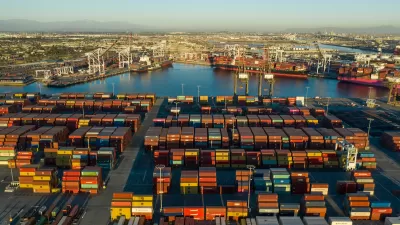In spite of doubts about economic viability, port cities on the Atlantic scramble to make room for mega cargo ships, Curtis Tate reports.
Cities across the East Coast are racing to prepare for an expansion of the Panama Canal, which officials hope will divert transcontinental shipping from the pavement to the sea. Slated for completion in 2014, the expansion will make way for cargo ships that can carry two to three times as many containers as the biggest ships currently on the route.
"I don't know too many ports that have gambled on shallow water that have stayed in the game," said Kevin Lynskey, the assistant director for seaport business initiatives at the Port of Miami. "If we didn't dredge and other people did, we certainly would lose more containers."
Ports on the southern end of the Eastern Seaboard, like those in Charleston, Savannah, and Miami, aren't currently deep enough to handle the new traffic, and worry that they might soon get passed over for larger ports up north. But with an already extensive, well-established rail network connecting the east and west coasts, those on the Pacific doubt the economic benefit of shifting gears.
"Why not just unload all of it here?" asked Art Wong, a spokesman for the Port of Long Beach. "We hope to maintain those kinds of advantages."
But the Southern port cities aren't waiting. State authorities in Flordia, Georgia, and South Carolina are proposing hundreds of millions of dollars in port expansions, drawing on state coffers if their pleas for federal funds fall on deaf ears.
FULL STORY: As states seek funds for deeper ports, will ships come in?

Alabama: Trump Terminates Settlements for Black Communities Harmed By Raw Sewage
Trump deemed the landmark civil rights agreement “illegal DEI and environmental justice policy.”

Study: Maui’s Plan to Convert Vacation Rentals to Long-Term Housing Could Cause Nearly $1 Billion Economic Loss
The plan would reduce visitor accommodation by 25% resulting in 1,900 jobs lost.

Why Should We Subsidize Public Transportation?
Many public transit agencies face financial stress due to rising costs, declining fare revenue, and declining subsidies. Transit advocates must provide a strong business case for increasing public transit funding.

Paris Bike Boom Leads to Steep Drop in Air Pollution
The French city’s air quality has improved dramatically in the past 20 years, coinciding with a growth in cycling.

Why Housing Costs More to Build in California Than in Texas
Hard costs like labor and materials combined with ‘soft’ costs such as permitting make building in the San Francisco Bay Area almost three times as costly as in Texas cities.

San Diego County Sees a Rise in Urban Coyotes
San Diego County experiences a rise in urban coyotes, as sightings become prevalent throughout its urban neighbourhoods and surrounding areas.
Urban Design for Planners 1: Software Tools
This six-course series explores essential urban design concepts using open source software and equips planners with the tools they need to participate fully in the urban design process.
Planning for Universal Design
Learn the tools for implementing Universal Design in planning regulations.
Smith Gee Studio
Alamo Area Metropolitan Planning Organization
City of Santa Clarita
Institute for Housing and Urban Development Studies (IHS)
City of Grandview
Harvard GSD Executive Education
Toledo-Lucas County Plan Commissions
Salt Lake City
NYU Wagner Graduate School of Public Service



























